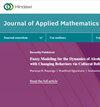延迟克里米亚-刚果出血热病毒人体模型的动力学分析
IF 1.2
Q2 MATHEMATICS, APPLIED
引用次数: 0
摘要
鉴于克里米亚和刚果出血热是一种致命的病毒性疾病,由于带菌者 "蜱 "的活动而季节性发生,因此研究和开发模拟这种疾病的数学模型至关重要。由于这种疾病在病人体内的潜伏期较长,论文涉及建立一个数学模型,模拟这种疾病从带菌者传染给人类以及在人类中传播的过程。主要目的是理解疾病传播的动态,以便对其进行控制,以及时间延迟对其产生的影响。其中包括对每一种解决方案的质量属性的讨论。根据既定的基本繁殖数,研究了存在或不存在延迟时流行平衡点和无疾病平衡点的稳定性分析。确定了霍普夫分岔的触发条件。利用中心流形定理和法线形式,探讨霍普夫分岔的方向和稳定性。下一步是敏感性分析,解释对系统行为产生影响的控制设置。最后,为了进一步理解模型的动态行为并验证已发现的分析结论,我们使用了数值模拟。本文章由计算机程序翻译,如有差异,请以英文原文为准。
Dynamics Analysis of a Delayed Crimean-Congo Hemorrhagic Fever Virus Model in Humans
Given that the Crimean and Congo hemorrhagic fever is one of the deadly viral diseases that occur seasonally due to the activity of the carrier “tick,” studying and developing a mathematical model simulating this illness are crucial. Due to the delay in the disease’s incubation time in the sick individual, the paper involved the development of a mathematical model modeling the transmission of the disease from the carrier to humans and its spread among them. The major objective is to comprehend the dynamics of illness transmission so that it may be controlled, as well as how time delay affects this. The discussion of every one of the solution’s qualitative attributes is included. According to the established basic reproduction number, the stability analysis of the endemic equilibrium point and the disease-free equilibrium point is examined for the presence or absence of delay. Hopf bifurcation’s triggering circumstance is identified. Using the center manifold theorem and the normal form, the direction and stability of the bifurcating Hopf bifurcation are explored. The next step is sensitivity analysis, which explains the set of control settings that have an impact on how the system behaves. Finally, to further comprehend the model’s dynamical behavior and validate the discovered analytical conclusions, numerical simulation has been used.
求助全文
通过发布文献求助,成功后即可免费获取论文全文。
去求助
来源期刊

Journal of Applied Mathematics
MATHEMATICS, APPLIED-
CiteScore
2.70
自引率
0.00%
发文量
58
审稿时长
3.2 months
期刊介绍:
Journal of Applied Mathematics is a refereed journal devoted to the publication of original research papers and review articles in all areas of applied, computational, and industrial mathematics.
 求助内容:
求助内容: 应助结果提醒方式:
应助结果提醒方式:


